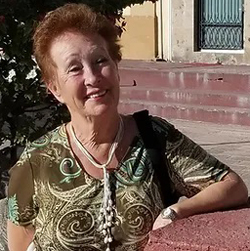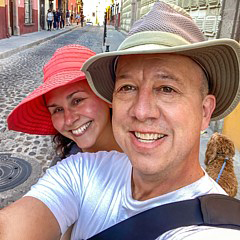
May 14, 2023
by Natalie Taylor with photos by Jack Paulus
A few weeks ago I walked by the Capilla de Loreto, and noticed the gate was open. A man in T-shirt and jeans was behind the grates. I approached him and asked if I could speak to the priest. "I am the priest," he said. I had not expected that, and when I told him about my research on the history of art in San Miguel, and asked to see the chapel, he willingly agreed. When I returned a week later, Father Juan Francisco welcomed me inside. I had brought along photographer Jack Paulus, and asked if it would be alright to take photos. He said yes.


We went through the doorway that leads to the Capilla de Loreto, where I had never set foot. Father Juan Francisco took us into the actual "santa casa"—the holy house, which is a replica of the house of Virgin Mary in Nazareth. According to Church tradition, the archangels "saved it from destruction" by transporting it to Loreto, Italy. Thus the name, Virgin of Loreto. The Capilla de Loreto has the same dimensions as the original house, and under the altar are the remains of Manuel Tomas de La Canal and his wife Maria. On the side, within niches, there are large, sculpted figures of each. I do not know of any other likeness of the two of the most famous historical figures of San Miguel el Grande, and most influential in the development and growth of the town during the 18th century. It was quite common for the wealthy to have their portraits painted, so I would not be surprised if there their paintings exist in some in a private collection, but I am not aware of any.
Inside the sacristy are many paintings on the walls. There is a collection of all the archangels, with Saint Michael the first and largest one on canvas. The rest are all on laminated copper. On the opposite wall there is a mural-sized painting with a signature and date: Andreas Lopez, 1795. Andreas Lopez was an accomplished novo-Hispanic painter who had studied with Miguel Cabrera, one of the most recognized painters of the colonial period.



Objects on credenza with Andreas Lopez's painting in the background. The Virgin of Advent on the left.
*
On a long credenza along the wall with the paintings of archangels, are many objects, including a painting of Virgin Mary that looks very Eastern Orthodox. Father Juan Francisco said it is the "virgen de adviento,"—Mary during her time of expectation of the birth of Jesus—the Advent, according to Christian theology. The other paintings throughout the sacristy depict all the famous conversions spoken of in the Bible.

A view of the Sacristy with Andreas Lopez's painting on the left
*
I asked about the Oratorians, and was told the order was originally founded by St Felipe Neri of Italy (1515-1595). The local, "congregacion del Oratorio de SMA" was founded by Luis Felipe Neri de Alfaro, who came from Mexico City in the 1700s. Aside from founding the church in Atotonilco, Felipe Neri de Alfaro started several traditions still practiced in SMA to this day. One of them is transporting the "Senor de la columna"—the Lord of the Column—every year. Father Juan Francisco said his canonization is "in the process," and can sometimes take centuries.

The Loreto chapel was commissioned by Manuel Tomas de la Canal, and built in 1733. A hundred years later, in 1834, remodeling included the construction of a dome by the architect Francisco Eduardo Tresguerras.
Father Juan Francisco showed us vestments, some of which are almost 300 years old, elaborately decorated and still used by the priests to this day.
Beyond the sacristy there is another small room with an amazing tapestry covering the entire ceiling, resembling intricate mosaic work. At the very end of the room, there is a lovely triple-stained-glass panel, made by a young man from San Miguel.
It was commissioned two years ago for the 400-year anniversary of the canonization of San Felipe Neri (the Italian saint). In the same room, he pointed to a trap door in the floor which he said leads to a basement, and lifted it to show us. "The old priests say it is part of the old San Miguel tunnels," he explained, and supposedly connects to Instituto Allende. I told him about another trap door in the Parroquia, which a young deacon showed me, and said was part of the old tunnel system.

In the hallway (when facing the gate that leads to Oratorio), there was an oil painting high on the wall, and quite hard to see. With his tripod, Jack was able to zoom in and get a good view of the painting. Father Juan Francisco was pleased to view it through the lens, since he himself had never seen it up close. We completed our visit with views of some of the ancient treasures, under lock and key, including a gold chalice.
In a future article I will speak about the other wonderful works found within the Chapel of Loreto.
Part II
**************

Natalie Taylor, born to Ukrainian parents, grew up in Argentina, where her family fled after WWII. They eventually moved to the U.S., and she spent most of her adult life there. She has a journalism degree, and an MFA in creative writing from Vermont College, Montpelier, VT. Her short stories, and poetry have been published in numerous literary magazines, and she has received several literary awards. She and her husband currently reside in San Miguel, where she has a weekly column in Atención, for which she also does translations. She has two books about San Miguel, available on Amazon or at the Tesoros Book Store: "Of All the Towns in All the World," and "SMA Self-Guided Historical Walking Tour." Her memoir, "The Tango House," will be coming out soon.
www.natalietaylor.org
**************

Jack Paulus has lived in SMA for a year and a half but this was his first Semana Santa. Before moving here he spent decades in the movie industry (Pixar). There expressing creativity collectively involved hundreds of other people. He observes, "I have been taking photos since the age of 12 and now I enjoy capturing life around me in images in a solo capacity."
www.jackpaulus.com
**************
*****
Please contribute to Lokkal,
SMA's online collective:
 ***
***
Discover Lokkal:
Watch the two-minute video below.
Then, just below that, scroll down SMA's Community Wall.
Mission

Visit SMA's Social Network
